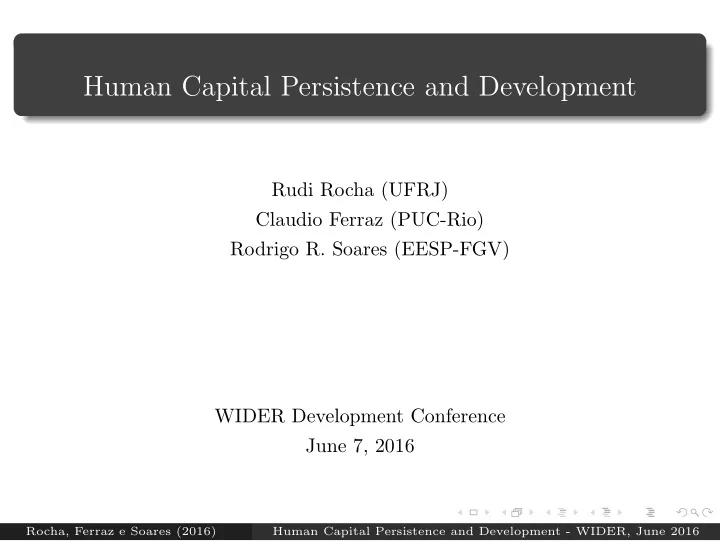

Human Capital Persistence and Development Rudi Rocha (UFRJ) Claudio Ferraz (PUC-Rio) Rodrigo R. Soares (EESP-FGV) WIDER Development Conference June 7, 2016 June Rocha, Ferraz e Soares (2016) Human Capital Persistence and Development - WIDER, June 2016
Motivation Human capital plays a key role in explaining modern cross-region and cross-country differences in income (Acemoglu and Dell 2010, Gennaioli et al. 2012). However, identifying human capital as a determinant of long-term development remains a challenge. Correlated mechanisms: Incentives of the elites (i.e. inequality and institutions). Characteristics of the population (i.e. ethnicity, culture, or religion). Geography. Dense literature: North and Thomas 1973; Acemoglu et al. 2002, Galor et al. 2009; Engerman et al., 2012; Easterly and Levine 2012; Acemoglu et al. 2014. June Rocha, Ferraz e Soares (2016) Human Capital Persistence and Development - WIDER, June 2016
This Paper... In a controlled empirical setting: we isolate the role of initial HK as a determinant of long-term development. More specifically, we explore variation in HK in late 19th/early 20th century induced by state sponsored settlements in SP. Between 1877-1915 the government of SP created 30 official settlement colonies across the state. Rural villages formed by small plots of land occupied by European immigrants with relatively more education. Regions with/out settlement colonies with similar pre-conditions. Education was the only observable dimension to change. We follow regions over time, document HK persistence, and long-run development; we provide evidence on likely mechanisms. June Rocha, Ferraz e Soares (2016) Human Capital Persistence and Development - WIDER, June 2016
Historical Background The context: Coffee expansion generated food shortage in urban centers. Slavery abolishment (1888) generated labor supply shortage at the agricultural frontier. Unclaimed public lands in backward areas and the in frontier. Among the political elite, there was a view that Europeans were more educated and productive than native workers. The main goal of the colonies was thus the attraction of European immigrants: a hook in the official propaganda. Because of different motivations, the same colonization framework was distributed across different regions of SP. June Rocha, Ferraz e Soares (2016) Human Capital Persistence and Development - WIDER, June 2016
Historical Background The framework: After legislative approval, public employees searched for locations mainly among unclaimed public lands. Exact location was chosen based on two conditions: soil fertility and proximity to transportation. Small plots of land were then designated and separated into different types (rural and urban). Plots of land were offered by Brazilian representatives in European cities. The land was not freely-given, it had to be paid in installments after the first harvest. After the payment of installments, the settler could claim the property right. The settlement was emancipated from public administration when all the plots were paid for. June Rocha, Ferraz e Soares (2016) Human Capital Persistence and Development - WIDER, June 2016
Historical Background June Rocha, Ferraz e Soares (2016) Human Capital Persistence and Development - WIDER, June 2016
Historical Background June Rocha, Ferraz e Soares (2016) Human Capital Persistence and Development - WIDER, June 2016
Data Settlements’ location: ASRs + case studies + ArqPubSP. Census (1872, 1920, 1940, 2000) + ASRs. Pre-existing conditions, 88 municipalities. Short-term: 1920, 202 municipalities (main division). Mid-term: 1940, 270 municipalities adjusted to 202 AMCs. Long-term: 2000, 645 municipalities adjusted to 202 AMCs. Controls: Geography (lat, long, soil quality etc). Coded railways across municipalities and over time. June Rocha, Ferraz e Soares (2016) Human Capital Persistence and Development - WIDER, June 2016
Empirical Models Estimating short-term effects: HK i , 1920 = α + β 1 Settlement i + X ′ i , 1872 β 2 + Geo ′ i β 3 + ǫ i Estimating mid/long-term effects, analogously: HK i , 1940 / 2000 = α + β 1 Settlement i + X ′ i , 1872 β 2 + Geo ′ i β 3 + ǫ i HK long-term effects on income, via 2SLS: Y i , 2000 on HK i , 1920 , instrumented by Settlement i June Rocha, Ferraz e Soares (2016) Human Capital Persistence and Development - WIDER, June 2016
Descriptive Statistics and Settlements’ Location June Rocha, Ferraz e Soares (2016) Human Capital Persistence and Development - WIDER, June 2016
Short-Term Effects on Human Capital June Rocha, Ferraz e Soares (2016) Human Capital Persistence and Development - WIDER, June 2016
Mid and Long-Term Effects on Human Capital June Rocha, Ferraz e Soares (2016) Human Capital Persistence and Development - WIDER, June 2016
Mid and Long-Term Effects on Human Capital June Rocha, Ferraz e Soares (2016) Human Capital Persistence and Development - WIDER, June 2016
Mid and Long-Term Effects on School Inputs June Rocha, Ferraz e Soares (2016) Human Capital Persistence and Development - WIDER, June 2016
Alternative Stories June Rocha, Ferraz e Soares (2016) Human Capital Persistence and Development - WIDER, June 2016
Alternative Stories June Rocha, Ferraz e Soares (2016) Human Capital Persistence and Development - WIDER, June 2016
Long-Term Effects on Income June Rocha, Ferraz e Soares (2016) Human Capital Persistence and Development - WIDER, June 2016
Channels: Structural Change June Rocha, Ferraz e Soares (2016) Human Capital Persistence and Development - WIDER, June 2016
Channels: Attracting More Human Capital June Rocha, Ferraz e Soares (2016) Human Capital Persistence and Development - WIDER, June 2016
Concluding Remarks We find that an increase in human capital due to state-sponsored settlements changed the level of education in treated regions; this increased level of HK persisted over time. Immigrants demanded schools and inputs in settlement areas, but still unclear why inputs persist. Intergenerational transmission of the value of education? Political economy mechanism? With high levels of internal migration, agglomeration and concentration of skills in more skill-intensive regions may have played an important role in the long-run. June Rocha, Ferraz e Soares (2016) Human Capital Persistence and Development - WIDER, June 2016
Recommend
More recommend